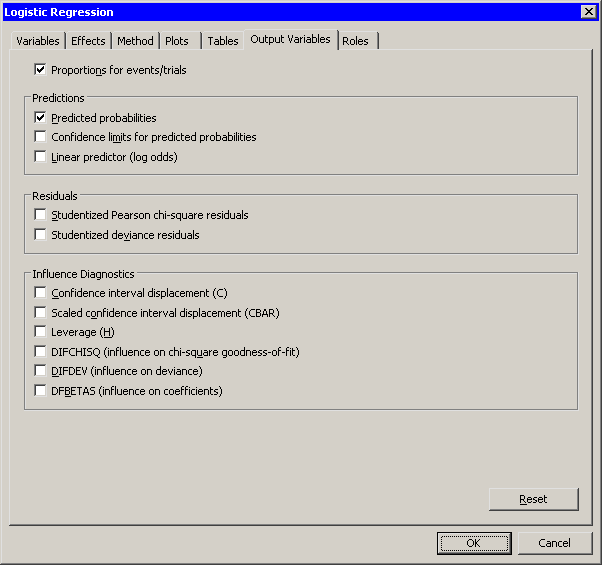| Model Fitting: Logistic Regression |
| Output Variables Tab |
You can use the Output Variables tab to add analysis variables to the data table. (See Figure 23.13.) If you request a plot that uses one of the output variables, then that variable is automatically created even if you did not explicitly select the variable on the Output Variables tab.
The following list describes each output variable and indicates how the output variable is named.  represents the name of the response variable. If you use events/trials syntax, then
represents the name of the response variable. If you use events/trials syntax, then  represents the name of the events variable.
represents the name of the events variable.
- Proportions for events/trials
adds a variable named Proportion_ , where
, where  is the name if the events variable and
is the name if the events variable and  is the name of the trials variable. The value of the variable is the ratio
is the name of the trials variable. The value of the variable is the ratio  . This variable is added only when you use events/trials syntax.
. This variable is added only when you use events/trials syntax. - Predicted probabilities
adds predicted probabilities. The variable is named LogiP_ .
. - Confidence limits for predicted probabilities
adds 95% confidence limits for the predicted probabilities. The variables are named LogiLclm_ and LogiUclm_
and LogiUclm_ .
. - Linear predictor (log odds)
adds the linear predictor values. The variable is named LogiXBeta_ .
. - Pearson chi-square residuals
adds the Pearson chi-square residuals. The variable is named LogiChiSqR_ .
. - Deviance residuals
adds the deviance residuals. The variable is named LogiDevR_ .
. - Confidence interval displacement (C)
adds the confidence interval displacement diagnostic, . The variable is named LogiC_
. The variable is named LogiC_ .
. - Scaled confidence interval displacement (CBAR)
adds the confidence interval displacement diagnostic, . The variable is named LogiCBar_
. The variable is named LogiCBar_ .
. - Leverage (H)
adds the leverage statistic. The variable is named LogiH_ .
. - DIFCHISQ (influence on chi-square goodness-of-fit)
adds the change in the chi-square goodness-of-fit statistic that is attributed to deleting the individual observation. The variable is named LogiDifChiSq_ .
. - DIFDEV (influence on deviance)
adds the change in the deviance that is attributed to deleting the individual observation. The variable is named LogiDifDev_ .
. - DFBETAS (influence on coefficients)
adds variables, where
variables, where  is the number of parameters in the model. The variables are scaled measures of the change in each parameter estimate and are calculated by deleting the
is the number of parameters in the model. The variables are scaled measures of the change in each parameter estimate and are calculated by deleting the  th observation. Large probabilities of DFBETAS indicate observations that are influential in estimating a given parameter. The variables are named DFBETA_
th observation. Large probabilities of DFBETAS indicate observations that are influential in estimating a given parameter. The variables are named DFBETA_ , where
, where  is the name of an interval regressor (including the intercept). For classification variables, the variables are named DFBETA_
is the name of an interval regressor (including the intercept). For classification variables, the variables are named DFBETA_ , where
, where  is the name of the variable and
is the name of the variable and  represents a level.
represents a level.

Copyright © SAS Institute, Inc. All Rights Reserved.